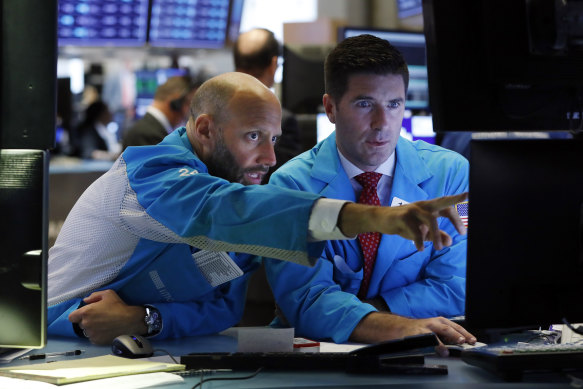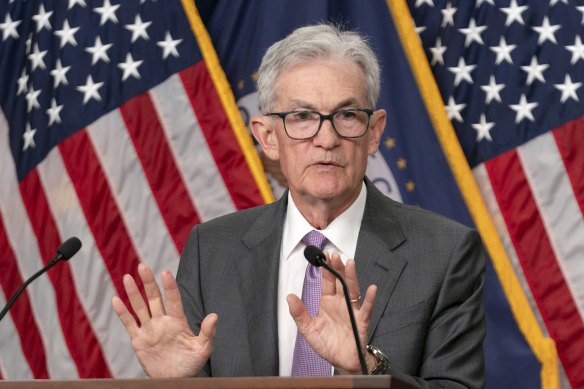Opinion
Sharemarkets gripped by panic amid fears the Fed just made a big mistake
Stephen Bartholomeusz
Senior business columnistDid the US Federal Reserve board make a fateful mistake last week that risks pushing the US economy into an avoidable recession?
Financial markets seem to think so, with the US sharemarket falling nearly 2 per cent on Friday. The tech-heavy Nasdaq index was down 2.43 per cent and the mega techs were down nearly 3 per cent. The Australian sharemarket has followed suit, plunging by about 3 per cent on Monday morning.

Wall Street’s VIX index, also known as the “fear index”, soared by 25 per cent on Friday. Credit: AP
Bond yields, which have been sliding, fell sharply – the 10-year bond had its biggest fall since the onset of the pandemic in 2020. Since late July that yield is now down about 50 basis points. Similarly, the yields on two-year Treasury notes have tumbled from 4.4 per cent at the start of the month to 3.88 per cent.
The VIX index, sometimes known as the “fear index”, which measures volatility, soared about 25 per cent on Friday and has risen from 16.36 at the start of the month to 23.4, a rise of almost 43 per cent.
Last Wednesday, after the two-day meeting of the Fed’s open market committee – the body that sets US interest rates – the Fed’s chair, Jerome Powell, said the US central bank needed more data before starting to cut US interest rates.
“The question will be whether the totality of the data, the evolving outlook and the balance of risks are consistent with rising confidence on inflation and maintaining a solid labour market,” he said.
He added that if that test were met, the first rate cut since the federal funds target rate peaked at 5.5 per cent last July could occur at the next meeting in September.
Powell got a crucial piece of that data on Friday.
The consensus among market economists was that July’s employment data would show the US economy had added about 175,000 jobs that month, well below the 194,000 average monthly increase in the first six months of the year but still a healthy number.
Instead, the data showed only 114,000 new jobs and an unemployment rate that rose from 4.1 per cent to 4.3 per cent, the sharpest increase since October 2021. The unemployment rate was as low as 3.4 per cent last year.

Fed chief Jerome Powell. The US central bank may have to unveil a jumbo rate cut next month. Credit: AP
In the past, according to what is known as the Sahm Rule (developed by US economist Claudia Sahm), when the unemployment rate’s three-month moving average increases by 50 basis points or more, it presages a recession.
That moving average is above half a percentage point on Friday’s numbers and, coming after another set of data that showed the US manufacturing sector is contracting, alarmed investors who are now worried that the Fed has missed the opportunity to orchestrate a soft landing for the economy and led to Friday’s sell-off. That also sparked a plunge on the Australian sharemarket on Monday morning.
Economists at Goldman Sachs increased the probability of a US recession from 15 per cent to 25 per cent after the data’s release.
The data also led to the futures markets pricing in a near-80 per cent chance that the Fed will go for a “jumbo” 50 basis-point rate cut at its September meeting rather than the 25 basis points that would normally be expected.
If that occurred, it would be a concession by the Fed that it had erred by waiting too long to respond to signs that the jobs market and economy are weakening, which might trigger even louder alarm bells.
At his media conference last Wednesday, Powell talked down the prospect of 50 basis point moves, saying that wasn’t something the Fed was considering.
If necessary, however, the Fed does have a lot of firepower, given that the effective federal funds rate (the US equivalent of the Reserve Bank’s cash rate) is 5.3 per cent. Before the rate-hiking cycle began in March 2022, the Fed was targeting a range of zero to 0.25 per cent.
It is unclear whether the Fed actually needs to press the panic button. One month’s data isn’t conclusive evidence, although June’s employment data was also revised down and, much like the Australian experience, there are clear signs emerging of the attritional effects of interest rates remaining high for a protracted period.
The US economy is still recording relatively solid growth – the annualised June quarter GDP growth rate was 2.8 per cent – and, even after Friday’s battering, the sharemarket, which is forward-looking, is still up about 12 per cent for the year. The inflation rate has been trending down steadily, with “core” inflation running close to the Fed’s 2 per cent target.
Assuming it does start a cycle of rate reductions next month, the Fed has an opportunity to finesse the soft landing for the economy that it, US companies, households and investors, are seeking. That’s even with hindsight that it might have been preferable if it had started the process last week, as a former New York Fed president, Bill Dudley, strongly argued in the lead-up to that meeting.
The way the turmoil within the US markets was mirrored in other financial markets underscores how significant the stakes are, not just for the US but global markets and other economies, if the Fed has miscalculated and inadvertently creates an avoidable recession in the world’s largest economy by leaving rates too high for too long.
The question mark over whether the Fed has misjudged the state of the economy also has political dimensions.
Donald Trump has been adamant that he would regard any rate cut ahead of the November election in the US as a political intervention by the Fed to help Kamala Harris and the Democrats.
Equally, the Democrats argue that a failure to cut rates in the face of the growing evidence of an economic slowdown would be an intervention of a different kind: one that would help Trump and the Republicans, who have made the Biden administration’s handling of the economy and the break-out of inflation a key point of their attack in the election campaign.
If clear evidence of a significant economic downturn does emerge in the lead-up to the election, history suggests it would be very difficult for the Democrats to retain the White House, let alone win control of either or both of the chambers of Congress, even though the jobless rate remains low by historical standards.
With Powell consistently stressing that the Fed will be influenced by the economics, not the politics, it now seems inevitable that there will be a rate cut next month, regardless of Trump’s views or his implicit threats to the Fed’s independence or its potential impact on the election.
The discussion now is not whether there will be a cut but how big it should be.
The Market Recap newsletter is a wrap of the day’s trading. Get it each weekday afternoon.